
Hi everybody!
I just got back to my hotel room after a nice walk in Downtown Indianapolis.
Today was another wonderful day for me at the US chess open since I won the US Open Blitz Championship with 12.5 points out of 14. I will write about this championship in a couple days, as now it's time for my chess story of the second day of the main event in the US Open 2009.
I wrote about my first 3 games in my previous post.
In the fourth round I was playing Black against the FM Carl Boor. I didn't face any problems in the opening with Black and soon after the opening we reached the following position:
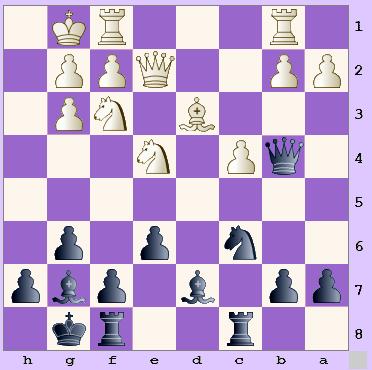
White just played 19. Rab1. It seems that White has to be doing OK. In fact they are already almost losing. Since after I played 19. ... f5! 20.Nc3 e5! I'm threatening to play e4 and then Nd4 and White's position is collapsing. My opponent tried to complicate the game after 21.Nd5 Qd6 22.c5 but I took the pawn on c5 22. ... Qxc5 and after 23.Bc4 Kh8 24.b4 Qd6 25.Rbd1 created a nice pawn chain by playing 25. ... e4
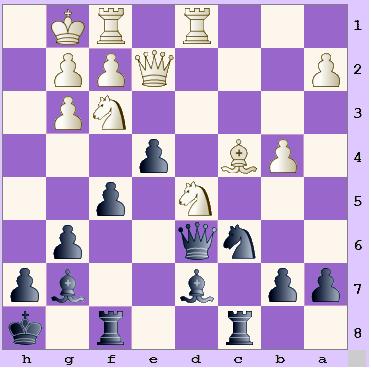 and 13 moves later I won the game.
and 13 moves later I won the game.
In the fifth round I played the most exciting game of my tournament against GM Nikola Mitkov.

In this position it's White to move. I was playing White and I liked my position very much during the game. The only problem since it was a 60-minutes game and I didn't have much time at this moment I wanted to find a plan to follow. 25.Re2 with the idea after Qg5 to play 26.Rae1 and to double my rooks on the e-file might have been the best decision here.
But I started a life-threatening operation to win the f4 pawn and played 25. Qf3 Qg5 26. Re4 Black took on b6 Bxb6
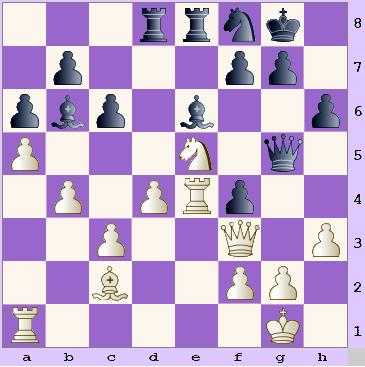 and here I almost automatically took on b6 since before playing 25. Qf3 I decided to go to the position that happened in the game but I missed the very strong 28th move for Black
and here I almost automatically took on b6 since before playing 25. Qf3 I decided to go to the position that happened in the game but I missed the very strong 28th move for Black
27. axb6?
Instead I could have played 27. h4!? since after Qxh4 28.Rxf4 Qg5 I have the very strong move 29.Nxf7! because if Black takes on f7 now 29...Bxf7 30.Rxf7 after Ba7 White will take 31.Rxb7 and then most likely will win the pawns on c6 and then on a6 and will have sufficient compensation for the bishop. If Black plays 29. ... Qe7 then after 30.Re1 Bc7 31.Nxd8 Qxd8
32.Rfe4 Qd5 33.Qd1 Qd6 34.Qh5 with the idea of playing Bb3 and despite the fact that Black has two pieces for a rook White has a good position.
Black played Bd5 asking what my idea was.
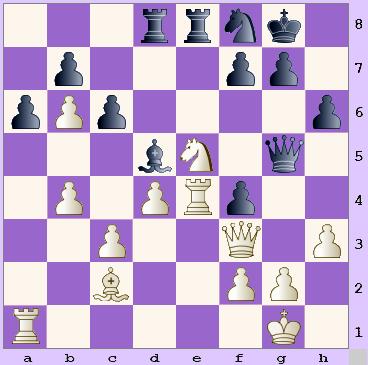
Obviously I had seen this position before playing 25. Qf3 and decided to play here
28. Qxf4 but missed the move f6!
At first I thought that I have to play 29. Qxg5 hxg5 30.Nxc6 Bxc6 and even though I have some compensation for the piece I was not happy with that since a few minutes ago my position was much better and now I will need to play for a draw. After a few more minutes I noticed an interesting idea and played
29. Nf3!? but objectively speaking 29. Qxg5 would have been stronger.
Rxe4 30.Qc7!
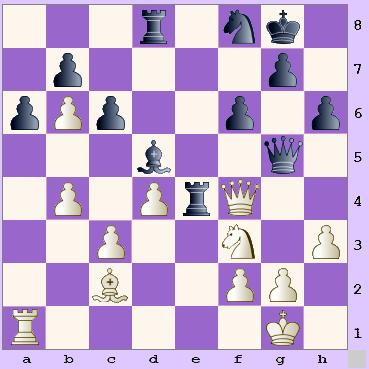
But my opponent found the very strong move Re1+! and I had to make a difficult choice again.
31.Nxe1
If White takes with the rook after 31.Rxe1 Bxf3 32.g3 Black has the strong move Re8! and White cannot take on e8 in view of 33. ... Qc1+ and Qh1# that's why I took on e1 with the knight.
Re8 with the idea to take on e1 and to give checkmate on g2 afterwards.
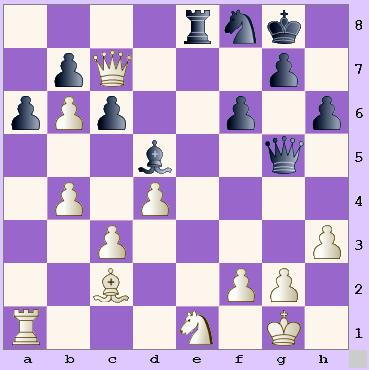
Of course I didn't play 32. Qg3 here since the only idea for me in this position is to try to promote the pawn on b6 even if I would need to sacrifice some material for that. That's why I chose
32.f3
and even though after
Qe3+ 33.Kh2 Qxc3 34.Rd1 Black won the knight Rxe1 35.Rxe1 Qxe1 36.Qxb7 my b6 pawn gave me enough compensation and forced Black to give away the bishop on d5 after Qd2 37.Qc7 Bxf3 38.Bb3+ Kh8 39.Qg3 Qxb4 40.Qxf3 Qxb6 Black has two extra pawns and probably their position is won but having less than a minute on my clock I was able to hold it and even at the very end my opponent forfeited on time but I only noticed it after I proposed a draw and he agreed. A very hard-fought draw and I had one more round to play and of course I wanted to finish the tournament on a good note.
In the sixth round I was playing Black against IM Daniel Fernandez. Interestingly enough I already met Daniel 5 years ago playing in the US open in Fort Lauderdale. That time I also played Black and won the game, so I was not against a small deja-vu. :)
We started the game with the sharp Sicilian Defence, Daniel didn't play precisely and I got a very dangerous initiative.

White just played 21. Bg4 I continued the game with the nice 21. ... d3! White replied 22. Bh2
If White plays 22.Kb1 then after dxc2+ 23.Qxc2 Black can take on f4 Qxf4
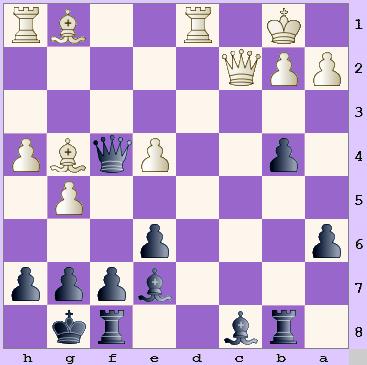
and after 24.Bh2 to play Qxg4 because if White takes on b8 now 25. Bxb8 Black has a strong move Bb7! with double attack on e4 and the bishop on b8 and the game can continue like this: 26. Rd4 Rc8! 27. Bc7 e5 28. Rc4 Rxc7!!. If White plays 25.Rhg1 Qxh4 26.Bg3 Qxg5
Back to the game after 22. Bh2 I played 22. ... b3! White has to take 23. axb3 Rxb3 24. f5 Qc6
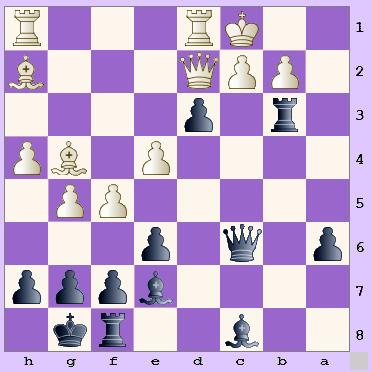
25. Be5
If White plays here 25. Kb1 then after Bb4 26. Qf2 Black can sacrifice the rook by playing 26. ... Rxb2! 27. Kxb2 Bc3+ 28.Kb3 e5 and White has no defence from coming Be6 and Rb8 since after 29. Qa7 Black plays Bd4, winning.
Qa4 26.Kb1 Rb5 27.Bc3 Qxe4 28.f6 Bb4 I completetly outplayed my opponent and am almost winning here but my opponent tries a very nice trick 29.Qxd3!?
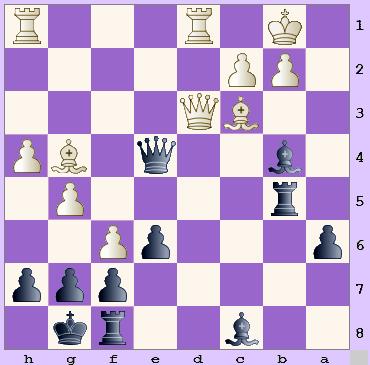
It's Black to move now. Try to find the best continuation for Black.
Probably I was tired here since it was already the third game of the day or maybe for some other reasons but I calculated the following variation:
29. ... Qxg4 30. fxg7 Re8 31. Qd8 threatening to take on e8 with checkmate and I decided that I have nothing to do and started looking for some other moves. Instead I should have continued the variation with 31. ... Bxc3 and after 32. Qxe8 it's only a check since the pawn on g7 is not protected anymore and I can simply take the pawn 32. ... Kxg7 and Black is winning since after 33. b3 Ra5 White has no defence from checkmate.
That's how I could have ended the game immediately, instead I found the very nice Queen sacrifice 29. ... Bxc3!? but unfortunately for me White doesn't have to take my Queen since after 30. Qxe4?? Black wins after 30. ... Rxb2+ 31. Kc1 Ra2 and in order to save from being checkmated White will need to give back his Queen.
My opponent replied 30. Qc3 and I had to start winning the game all over again which I managed to do in a nice way. You can watch the rest of the game simply by copying the moves below and pasting them into the pgnplayer.com
[Event "US open"]
[Site "Indianapolis (USA)"]
[Date "2009.08.07"]
[Round "6"]
[White "Fernandez, Daniel"]
[Black "Kosteniuk, Alexandra"]
[Result "0-1"]
[ECO "B63"]
1.e4 c5 2.Nf3 d6 3.d4 cxd4 4.Nxd4 Nf6 5.Nc3 Nc6 6.Bg5 e6 7.Qd2
Be7 8.O-O-O Qb6 9.Nb3 O-O 10.f3 a6 11.Be3 Qc7 12.g4 b5 13.g5 Nd7 14.h4 b4 15.Na4
Nce5 16.Nd4 Rb8 17.f4 Ng4 18.Bg1 Nc5 19.Nxc5 dxc5 20.Be2 cxd4 21.Bxg4 d3 22.Bh2 b3 23.axb3 Rxb3 24.f5 Qc6 25.Be5 Qa4 26.Kb1 Rb5 27.Bc3 Qxe4 28.f6 Bb4 29.Qxd3 Bxc3
30.Qxc3 Bb7 31.Rhg1 Bd5 32.Rd4 Qe5 33.Re1 Qb8 34.fxg7 Rc8 35.Qa3
Qb6 36.Rf4 Rb8 37.Bh5 Rxb2+ 38.Kc1 e5 39.Rff1 Qd4 40.Qd3 Qb4
41.Kd1 Rb1+ 0-1
That's how my second day of the US open 2009 finished. Be sure to check the blog next week since I will try to prepare a story about the US open blitz championship as well as I will comment and post some videos with the games from the blitz championship to my YouTube Channel - www.youtube.com/chessqueen .
I will also announce the first three winners of the Alexandra Kosteniuk ChessBlog Grand-Prix Puzzle Contest. So if you haven't sent your solutions to the first three puzzles, you still have a few days to do so.
Posted by: Alexandra Kosteniuk
Women's World Chess Champion
www.chessblog.com
In the fourth round I was playing Black against the FM Carl Boor. I didn't face any problems in the opening with Black and soon after the opening we reached the following position:

White just played 19. Rab1. It seems that White has to be doing OK. In fact they are already almost losing. Since after I played 19. ... f5! 20.Nc3 e5! I'm threatening to play e4 and then Nd4 and White's position is collapsing. My opponent tried to complicate the game after 21.Nd5 Qd6 22.c5 but I took the pawn on c5 22. ... Qxc5 and after 23.Bc4 Kh8 24.b4 Qd6 25.Rbd1 created a nice pawn chain by playing 25. ... e4
 and 13 moves later I won the game.
and 13 moves later I won the game.In the fifth round I played the most exciting game of my tournament against GM Nikola Mitkov.

In this position it's White to move. I was playing White and I liked my position very much during the game. The only problem since it was a 60-minutes game and I didn't have much time at this moment I wanted to find a plan to follow. 25.Re2 with the idea after Qg5 to play 26.Rae1 and to double my rooks on the e-file might have been the best decision here.
But I started a life-threatening operation to win the f4 pawn and played 25. Qf3 Qg5 26. Re4 Black took on b6 Bxb6
 and here I almost automatically took on b6 since before playing 25. Qf3 I decided to go to the position that happened in the game but I missed the very strong 28th move for Black
and here I almost automatically took on b6 since before playing 25. Qf3 I decided to go to the position that happened in the game but I missed the very strong 28th move for Black27. axb6?
Instead I could have played 27. h4!? since after Qxh4 28.Rxf4 Qg5 I have the very strong move 29.Nxf7! because if Black takes on f7 now 29...Bxf7 30.Rxf7 after Ba7 White will take 31.Rxb7 and then most likely will win the pawns on c6 and then on a6 and will have sufficient compensation for the bishop. If Black plays 29. ... Qe7 then after 30.Re1 Bc7 31.Nxd8 Qxd8
32.Rfe4 Qd5 33.Qd1 Qd6 34.Qh5 with the idea of playing Bb3 and despite the fact that Black has two pieces for a rook White has a good position.
Black played Bd5 asking what my idea was.

Obviously I had seen this position before playing 25. Qf3 and decided to play here
28. Qxf4 but missed the move f6!
At first I thought that I have to play 29. Qxg5 hxg5 30.Nxc6 Bxc6 and even though I have some compensation for the piece I was not happy with that since a few minutes ago my position was much better and now I will need to play for a draw. After a few more minutes I noticed an interesting idea and played
29. Nf3!? but objectively speaking 29. Qxg5 would have been stronger.
Rxe4 30.Qc7!

But my opponent found the very strong move Re1+! and I had to make a difficult choice again.
31.Nxe1
If White takes with the rook after 31.Rxe1 Bxf3 32.g3 Black has the strong move Re8! and White cannot take on e8 in view of 33. ... Qc1+ and Qh1# that's why I took on e1 with the knight.
Re8 with the idea to take on e1 and to give checkmate on g2 afterwards.

Of course I didn't play 32. Qg3 here since the only idea for me in this position is to try to promote the pawn on b6 even if I would need to sacrifice some material for that. That's why I chose
32.f3
and even though after
Qe3+ 33.Kh2 Qxc3 34.Rd1 Black won the knight Rxe1 35.Rxe1 Qxe1 36.Qxb7 my b6 pawn gave me enough compensation and forced Black to give away the bishop on d5 after Qd2 37.Qc7 Bxf3 38.Bb3+ Kh8 39.Qg3 Qxb4 40.Qxf3 Qxb6 Black has two extra pawns and probably their position is won but having less than a minute on my clock I was able to hold it and even at the very end my opponent forfeited on time but I only noticed it after I proposed a draw and he agreed. A very hard-fought draw and I had one more round to play and of course I wanted to finish the tournament on a good note.
In the sixth round I was playing Black against IM Daniel Fernandez. Interestingly enough I already met Daniel 5 years ago playing in the US open in Fort Lauderdale. That time I also played Black and won the game, so I was not against a small deja-vu. :)
We started the game with the sharp Sicilian Defence, Daniel didn't play precisely and I got a very dangerous initiative.

White just played 21. Bg4 I continued the game with the nice 21. ... d3! White replied 22. Bh2
If White plays 22.Kb1 then after dxc2+ 23.Qxc2 Black can take on f4 Qxf4

and after 24.Bh2 to play Qxg4 because if White takes on b8 now 25. Bxb8 Black has a strong move Bb7! with double attack on e4 and the bishop on b8 and the game can continue like this: 26. Rd4 Rc8! 27. Bc7 e5 28. Rc4 Rxc7!!. If White plays 25.Rhg1 Qxh4 26.Bg3 Qxg5
Back to the game after 22. Bh2 I played 22. ... b3! White has to take 23. axb3 Rxb3 24. f5 Qc6

25. Be5
If White plays here 25. Kb1 then after Bb4 26. Qf2 Black can sacrifice the rook by playing 26. ... Rxb2! 27. Kxb2 Bc3+ 28.Kb3 e5 and White has no defence from coming Be6 and Rb8 since after 29. Qa7 Black plays Bd4, winning.
Qa4 26.Kb1 Rb5 27.Bc3 Qxe4 28.f6 Bb4 I completetly outplayed my opponent and am almost winning here but my opponent tries a very nice trick 29.Qxd3!?

It's Black to move now. Try to find the best continuation for Black.
Probably I was tired here since it was already the third game of the day or maybe for some other reasons but I calculated the following variation:
29. ... Qxg4 30. fxg7 Re8 31. Qd8 threatening to take on e8 with checkmate and I decided that I have nothing to do and started looking for some other moves. Instead I should have continued the variation with 31. ... Bxc3 and after 32. Qxe8 it's only a check since the pawn on g7 is not protected anymore and I can simply take the pawn 32. ... Kxg7 and Black is winning since after 33. b3 Ra5 White has no defence from checkmate.
That's how I could have ended the game immediately, instead I found the very nice Queen sacrifice 29. ... Bxc3!? but unfortunately for me White doesn't have to take my Queen since after 30. Qxe4?? Black wins after 30. ... Rxb2+ 31. Kc1 Ra2 and in order to save from being checkmated White will need to give back his Queen.
My opponent replied 30. Qc3 and I had to start winning the game all over again which I managed to do in a nice way. You can watch the rest of the game simply by copying the moves below and pasting them into the pgnplayer.com
[Event "US open"]
[Site "Indianapolis (USA)"]
[Date "2009.08.07"]
[Round "6"]
[White "Fernandez, Daniel"]
[Black "Kosteniuk, Alexandra"]
[Result "0-1"]
[ECO "B63"]
1.e4 c5 2.Nf3 d6 3.d4 cxd4 4.Nxd4 Nf6 5.Nc3 Nc6 6.Bg5 e6 7.Qd2
Be7 8.O-O-O Qb6 9.Nb3 O-O 10.f3 a6 11.Be3 Qc7 12.g4 b5 13.g5 Nd7 14.h4 b4 15.Na4
Nce5 16.Nd4 Rb8 17.f4 Ng4 18.Bg1 Nc5 19.Nxc5 dxc5 20.Be2 cxd4 21.Bxg4 d3 22.Bh2 b3 23.axb3 Rxb3 24.f5 Qc6 25.Be5 Qa4 26.Kb1 Rb5 27.Bc3 Qxe4 28.f6 Bb4 29.Qxd3 Bxc3
30.Qxc3 Bb7 31.Rhg1 Bd5 32.Rd4 Qe5 33.Re1 Qb8 34.fxg7 Rc8 35.Qa3
Qb6 36.Rf4 Rb8 37.Bh5 Rxb2+ 38.Kc1 e5 39.Rff1 Qd4 40.Qd3 Qb4
41.Kd1 Rb1+ 0-1
That's how my second day of the US open 2009 finished. Be sure to check the blog next week since I will try to prepare a story about the US open blitz championship as well as I will comment and post some videos with the games from the blitz championship to my YouTube Channel - www.youtube.com/chessqueen .
I will also announce the first three winners of the Alexandra Kosteniuk ChessBlog Grand-Prix Puzzle Contest. So if you haven't sent your solutions to the first three puzzles, you still have a few days to do so.
Posted by: Alexandra Kosteniuk
Women's World Chess Champion
www.chessblog.com
29 ...Qxg4 30. fxg7 Re8 31. Qd7 Bxd7 .. :p
ReplyDeleteI liked very much this post. Congratulations for your games! About the Puzzle Contest it doesn`t finished in Aug 31? I solved the easy and the intermediate, but i'm working on the difficult yet! I follow you on Twitter.
ReplyDeleteThe game against IM Fernandez is specially nice. You conduct a relentless attack and the game turns out to be very one-sided while at the beginning it seemed like white was going to have some attacking chances. An enjoyable game. Congrats!
ReplyDeleteIn Fernandez game, where R the sacrifices!? in any case I enjoyed replaying ur games, thanks 4 making them available and thank you 4 telling us about the availability of PGNPLAYER, A very helpful tool.
ReplyDelete